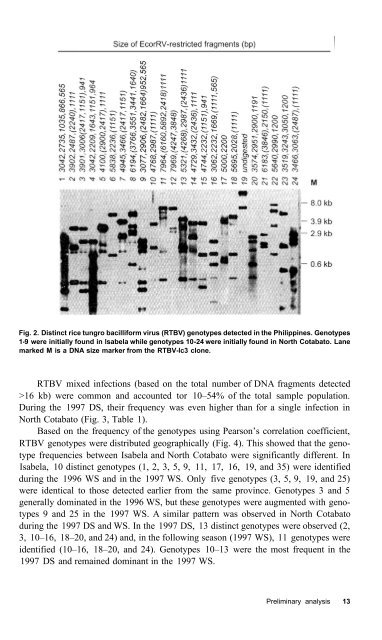- Page 2 and 3: RiceTungro DiseaseManagementEdited
- Page 4 and 5: ContentsRice tungro disease in the
- Page 6 and 7: ForewordThe intensification of rice
- Page 8 and 9: PrefaceProviding farmers with optio
- Page 10 and 11: Rice tungro disease in the Philippi
- Page 12 and 13: Cotabato, and Laguna) during 1995-9
- Page 14 and 15: seed growers and farmers to increas
- Page 16 and 17: Fig. 2. Incidence of rice tungro di
- Page 18 and 19: De los Reyes JB, Cabunagan, RC, Col
- Page 20 and 21: Preliminary analysis of genetic var
- Page 24 and 25: Fig. 4. Dendogram depicting the rel
- Page 26 and 27: Preliminary analysis of genetic var
- Page 28 and 29: Table 1. Size characteristics of th
- Page 30 and 31: varieties and did not seem to exert
- Page 32 and 33: Developing breeding lines with RTD
- Page 34 and 35: In CES, 28 entries had low tungro i
- Page 36 and 37: Table 2. Best rice tungro disease-r
- Page 38 and 39: Breeding for rice tungro virus resi
- Page 40 and 41: Table 2. Promising lines resistant
- Page 42 and 43: Table 4. Rice cultivars used as hyb
- Page 44 and 45: Shahjahan MB, Jalani S, Zakri AH, I
- Page 46 and 47: Table 1. Initial 19 transgenic line
- Page 48 and 49: Table 4. Percent infection of trans
- Page 50 and 51: very low level. In fact, transgene
- Page 52 and 53: of Agricultural Research (ICAR). Pr
- Page 54 and 55: Fig. 2. Mean infection with rice tu
- Page 56 and 57: (RTBV) and rice tungro spherical vi
- Page 58 and 59: Table 4. Percent infection a with r
- Page 60 and 61: GLH numbers were much lower on IR62
- Page 62 and 63: Cabunagan RC, Hibino H, Sama S, Riz
- Page 64 and 65: Prospects of virus-resistant variet
- Page 66 and 67: Tungro in Bali (1987-97)Tungro infe
- Page 68 and 69: Fig. 5. Proportion of varieties gro
- Page 70 and 71: Table 3. Percent incidence of rice
- Page 72 and 73:
Evaluating rice germplasm for resis
- Page 74 and 75:
Table 2. Percent infection a with r
- Page 76 and 77:
Rice tungro disease resistance andm
- Page 78 and 79:
Table 1. Percent infection a with r
- Page 80 and 81:
ecommended vector-resistant variety
- Page 82 and 83:
Materials and methodsBatches of ant
- Page 84 and 85:
ReferencesClark MF, Adams AN. 1977.
- Page 86 and 87:
(e.g., Sokal and Rohlf 1995, p 213;
- Page 88 and 89:
Surveillance scheme for tungro fore
- Page 90 and 91:
entrusted with implementing the pro
- Page 92 and 93:
Table 1. Number of mobile nursery t
- Page 94 and 95:
are implemented immediately. The co
- Page 96 and 97:
Farmers’ rice tungro managementpr
- Page 98 and 99:
Experience with tungroAlthough both
- Page 100 and 101:
Table 5. Farmers (%) reporting tung
- Page 102 and 103:
Table 7. Farmers’ reported tungro
- Page 104 and 105:
Table 9. Mean number (standard devi
- Page 106 and 107:
than rice), so they may be reluctan
- Page 108 and 109:
Community-based rice pest managemen
- Page 110 and 111:
Establishment of farmers’ indigen
- Page 112 and 113:
Meanwhile, insects, diseases, and n
- Page 114 and 115:
Table 2. Most important diseases fo
- Page 116 and 117:
Farmers’ knowledge of pest contro
- Page 118 and 119:
ha -1 and above) had a lower RTD in
- Page 120 and 121:
Fig. 4. Three major peaks of green
- Page 122 and 123:
RBB hill -1 and 4% WSB (Fig. 6). In
- Page 124 and 125:
The influence of varietal resistanc
- Page 126 and 127:
Limited data exist on how resistant
- Page 128 and 129:
tember plantings, reaching 13% and
- Page 130 and 131:
Holt J, Chancellor TCB, Reynolds DR
- Page 132 and 133:
glh4, respectively. Planting at the
- Page 134 and 135:
Results and discussionMinimum unit
- Page 136 and 137:
Fig. 4. Transmission efficiency of
- Page 138 and 139:
Table 1. Enzyme-linked immunosorben
- Page 140 and 141:
Leafhopper control by insecticides
- Page 142 and 143:
Fig. 1. Cartoon used for tungro man
- Page 144 and 145:
The role of vector control in rice
- Page 146 and 147:
To establish relationships between
- Page 148 and 149:
Fig. 1. Influence of antifeedants o
- Page 150 and 151:
Fig. 4. Tungro incidence before har
- Page 152 and 153:
ReferencesAryawan IGN, Widiarta IN,
- Page 154 and 155:
Materials and methodsSeedbed protec
- Page 156 and 157:
Table 2. Relationship of RTD incide
- Page 158 and 159:
Management of rice tungro disease b
- Page 160 and 161:
Results and discussionGLH populatio
- Page 162 and 163:
Table 4. Field evaluation of foliar
- Page 164 and 165:
3.6 to 2.7 t ha -1 . These yields w
















